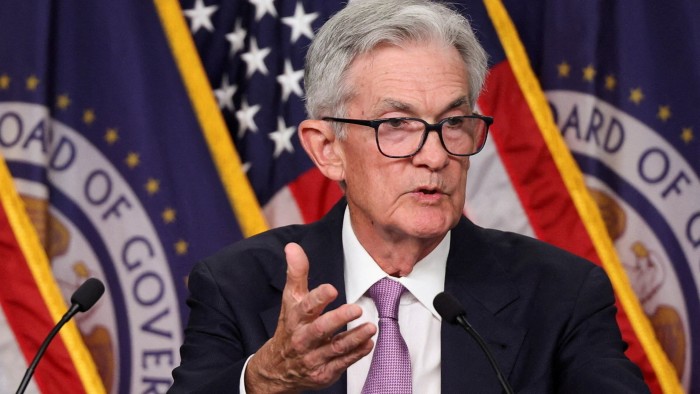Unlock the White House Watch newsletter for free
Your guide to what Trump’s second term means for Washington, business and the world
The US Federal Reserve is widely expected to keep interest rates at their present level when it meets next week, with chair Jay Powell’s press conference likely to be investors’ main focus following a volatile month for financial markets.
Donald Trump’s erratic tariff announcements have buffeted US stocks, Treasuries and the dollar in recent weeks while fanning concerns about slower growth and higher inflation in the world’s biggest economy. The president has repeatedly signalled that he thinks interest rates should be lowered to stimulate the economy.
Yet data released on Friday showing the US added 177,000 jobs in April, more than economists had expected, bolstered investors’ conviction that the Fed will remain on hold. Traders in swaps markets are currently pricing in close to a 97 per cent chance that rates will remain between 4.25 and 4.5 per cent.
Wednesday’s central bank meeting “looks like a placeholder: policy rates on hold and no change in Chair Powell’s tone from his recent speeches,” said Bank of America strategists led by Aditya Bhave.
“We think the bar for a June cut is high, but Powell is unlikely to rule it out at this stage,” he added.
Trump last month renewed his criticism of the Fed chair, claiming he has the right to fire Powell, who he has lambasted for being “too slow” to lower rates. Asked whether he would sack the central banker, Trump said: “If I want him out, he’ll be out real fast, believe me.”
US stocks and the dollar sold off sharply on the comments as investors worried that the central bank’s independence was under threat only to rebound after Trump rowed back.
Powell is likely to sidestep any questions about his relationship with Trump, but his views on the potential impact of the president’s tariffs on inflation and employment will be scrutinised. George Steer
Will the Bank of England signal more cuts?
Traders are fully expecting the UK’s central bank to reduce its policy rate by a quarter point to 4.25 per cent at its meeting on Thursday, according to levels implied by swaps markets. Most expect three more cuts of the same magnitude to follow before the end of the year.
What the Bank of England signals on the inflationary outlook will be crucial to whether those expectations hold. Analysts at Barclays are expecting the bank to cut its inflation forecast, “signalling that the balance of risks has shifted to a less inflationary outlook”. That will “open the door to a June cut without explicitly referencing it, to retain optionality”, they argue.
Like other major central banks, the BoE is caught between the growth impacts and inflationary effects of Donald Trump’s stop-start trade war, making any decision to adjust monetary policy in response fraught with difficulty. Recent UK economic data has been mixed, with better than expected retail sales in March but weak readings of business activity.
BoE governor Andrew Bailey has warned that the central bank must “take seriously” the risks to growth from the tariff surge. The hawkish rate setter Megan Greene, has said that the effect of global tariffs will probably be disinflationary for the UK.
JPMorgan’s Allan Monks is expecting a “dovish shift” from the BoE on the impact of tariffs. “While potential supply chain impacts remain one consideration, weaker growth and an excess supply of Chinese goods may prove more dominant,” he argues, saying currency moves have not added to the inflationary pressures as would have been expected. But he expects the bank to be “cautious” in putting much weight on this disinflationary view. Ian Smith and Valentina Romei
Have stocks passed peak anxiety over tariffs?
This week’s rally in global stocks saw Wall Street’s blue-chip S&P 500 recoup all of its sharp losses since Donald Trump’s April 2 announcement of so-called “reciprocal” tariffs roiled markets.
After a dramatic 9 per cent drop in the first week of April, US stocks started to regain ground after the president announced a 90-day tariff pause on April 9. David Lefkowitz, Head US Equities at UBS Global Wealth Management said the U-turn “gave us the confidence to re-upgrade equities”.
Last week, investors were further cheered by progress towards US-China trade talks, as well strong earnings reports from US tech giants, and encouraging data on the American economy. But the policy environment remains far from certain, with little tangible progress towards trade deals secured. That leaves many analysts feeling nervous about piling back into a market that saw such dramatic falls so recently. The question for equity investors is: is the worst over, or is it still yet to come?
The rally is “quite astonishing considering the big shake up of global trade that has happened in the span of four weeks,” said Elyas Galou, senior investment strategist at Bank of America, adding that it “shows that investors remain fundamentally bullish on the outlook for US equities, rates and the dollar”.
“The strategy of the Trump administration was to frontload the bad news,” he said “Now the market is frontloading the next 100 days. I think this period will focus on lower taxes, lower tariff rates,” he explained.
Others are more cautious. “We think the rally off the lows is more a function of position capitulation than an ‘all clear’ signal for risk,” read a BNP Paribas analysis note, adding that earnings downgrades “could see equities re-test year-to-date low”. Emily Herbert

